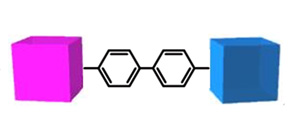
A world-first: Formation of direct covalent bond achieved in macroscopic cross-coupling reaction!
Directly bonds materials at the molecular level
A group of researchers led by HARADA Akira (Distinguished Professor, Graduate School of Science, Osaka University) achieved the adhesion of materials through direct covalent bond formation by making use of a Suzuki-Miyaura coupling reaction, a world first. This group's new technique is capable of directly bonding materials via chemical reactions at the molecular level. By making use of a Suzuki-Miyaura coupling reaction that uses a palladium catalyst at the contact interface between a gel possessing a phenylboronic group (PB-gel) and acrylamide gel modified with an iodophenyl group (I-gel) and also between glass substrates possessing substituents corresponding these hydrogels, this group achieved adhesion through direct covalent bond formation. This group's adhesion method through direct covalent bond formation has made it possible to stably adhere macroscopic materials to one another without adhesives.
Previously, this group reported on the direct adhesion between hydrogels making use of inclusion reactions of cyclodextrins (CDs). This demonstrated molecular recognition through host-guest reaction between CD and hydrocarbon molecules at the micro scale as a microscopic event of direct adhesion of hydrogels. In this way, this group achieved the direct adhesion of materials via non-covalent bonds. Based on this discovery, this group aimed to develop a new method for directly bonding materials via covalent bond formation, considered capable of achieving a more stable, stronger adhesion of materials than non-covalent bond formation achieved.
This group also investigated the more challenging topic of bonding between different material types. Just as in the case of adhesion between gels, the adhesion was not achieved without boron, iodine, or the catalyst palladium. Furthermore, the bonding strength between the gel and the substrate increased in accord with the increase in functional group's feed ratio of the gel. From these findings, this group found that the adhesion mechanism for making use of covalent bond formation could be used not only for bonding between soft materials, gels, but also for bonding between soft and hard materials. Although two materials adhered with adhesives were separated in organic solvent, two materials adhered with this group's method didn't separate in organic solvent because materials were firmly adhered to one another via the formation of covalent bonds.
This group's method for achieving direct covalent bond formation shows this method has a wide range of application and, moreover, that its stability in various situations will be sought after. This group's new technique for achieving adhesion through direct covalent bonding will be used in various fields such as biomaterials and material engineering.
Abstract
Cross-coupling reactions are important to form C–C covalent bonds using metal catalysts. Although many different cross-coupling reactions have been developed and applied to synthesize complex molecules or polymers (macromolecules), if cross-coupling reactions are realized in the macroscopic real world, the scope of materials should be dramatically broadened. Here, Suzuki-Miyaura coupling reactions are realized between macroscopic objects. When acrylamide gel modified with an iodophenyl group (I-gel) reacts with a gel possessing a phenylboronic group (PB-gel) using a palladium catalyst, the gels bond to form a single object. This concept can also be adapted for bonding between soft and hard materials. I-gel or PB-gel selectively bonds to the glass substrates whose surfaces are modified with an electrophile or nucleophile, respectively.

Figure 1 : A direct adhesion between macroscopic objects through the Suzuki-Miyaura cross-coupling reaction

Figure 2: (a) Chemical structures of PB-gel(x), I-gel(x) and AAm-gel. (b) The adhesion of PB-gel(10) and I-gel(10). (c) The adhesion of PB-Sub and I-gel(10).
To learn more about this research, please view the full research report entitled " A Macroscopic Reaction: Direct Covalent Bond Formation between Materials Using a Suzuki-Miyaura Cross-Coupling Reaction " at this page of the Scientific Reports website.
Related link :
